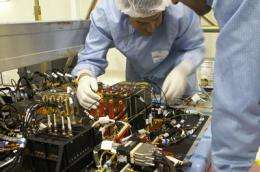Hylas, a flexible, broadband Ka-band satellite, is steadily moving towards completion. The communications payload has been shipped from England to India for integration with the platform, marking a key milestone for the project. Credits: EADS Astrium UK
(PhysOrg.com) -- Hylas, a flexible, broadband Ka-band satellite, is steadily moving towards completion. The communications payload has been shipped from England to India for integration with the platform, marking a key milestone for the project.
This important step was completed in late October by Astrium UK, the prime contractor for the Hylas satellite, supported by Avanti Communications, the satellite customer and operator, and ESA, partner and co-funder of the project. The next phase involves the integration of payload and platform systems and the execution of the satellite-level test programme, prior to launch in 2010.
The Hylas mission will address the large demand for broadband services in Europe that cannot be met by terrestrial networks. It will provide capacity to serve hundreds of thousands of Internet users, and broadcast up to 30 standard-quality or 15 high-definition TV channels in Ku-band.
Astrium is leading the design and manufacture of Hylas and is responsible for developing the advanced Ku- and Ka-band payload. The Indian Space Research Organisation (ISRO), in Bangalore, India, is providing the satellite platform. The communications payload and the platform will be integrated and tested in Bangalore, in preparation for the launch by Arianespace in 2010. Other European and Canadian companies, including TESAT, ComDev and CASA Espacio, are providing essential equipment for the payload.
“The Generic Flexible Payload technology, developed by Astrium, is at the heart of the communications module,” explains Andrew Murrell, Hylas Payload Engineer for ESA. “It is based on highly integrated equipment that provides in-orbit flexibility to adapt the satellite’s frequency plan and connectivity to match evolving market demands. The use of the newly developed, flexible travelling wave tube amplifier from TESAT enables further optimisation of satellite resources by allowing power to be reallocated between service regions according to changing needs.”
While broadband services for domestic and business customers form the core application for Hylas, the system has been designed to support the provision of other communications applications such as HDTV broadcasting and data contribution and distribution services.
A contract was signed between ESA and Avanti for the development of Hylas in 2006, providing support for the development of the most innovative elements of this new system. The satellite is designed to have a lifetime of 15 years, and will be positioned in geostationary orbit at 33.5°W.
Provided by European Space Agency (news : web)




















